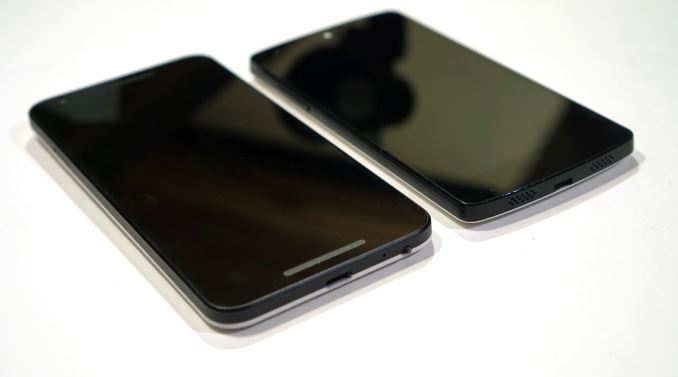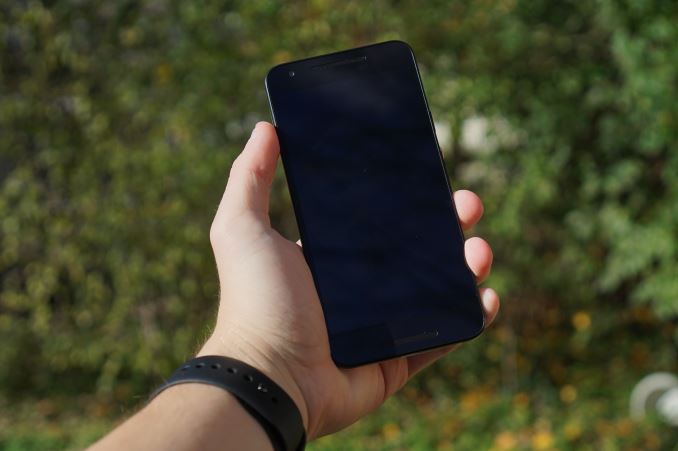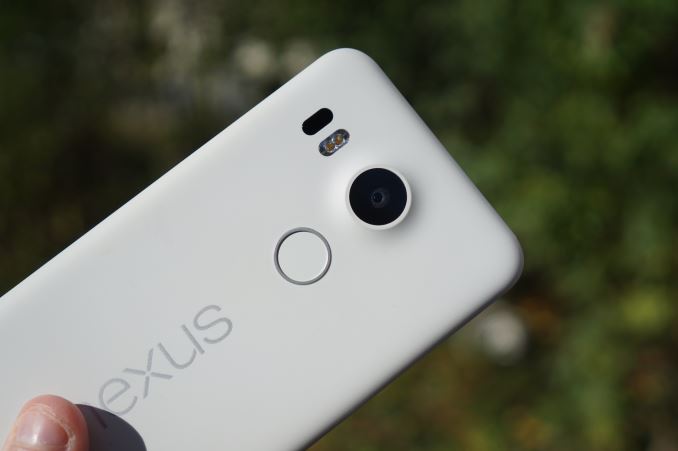The Google Nexus 5X Review
by Brandon Chester on November 9, 2015 8:00 AM EST- Posted in
- Smartphones
- LG
- Mobile
- Android 6.0
- Nexus 5X
Final Words
The Nexus 5X certainly isn't a perfect device. It's not meant to be a flagship phone and it's not priced like one; at $379 it's not the most expensive phone out there, but it's not exactly the cheapest one either. Still, I find myself really liking it despite its flaws. I definitely have a soft spot in my heart for the original Nexus 5, and I was quite disappointed when it didn't receive a true successor last year.
This year's 5X certainly is a true successor, but not every aspect delivers the improvements you would expect from a two year gap between releases. The performance isn't where you'd expect it to be, and Google's stance on disk encryption continues to reduce NAND performance. For all the things the 5X gets wrong though, it gets many other things really right. As always, it's nice to gather everything together in order to decide if a device is worth purchasing.
The design of the 5X is an interesting evolution of the LG Nexus industrial design. It's not as angular as the Nexus 5, but it's still very much a Nexus phone. The design delivered everything I expected from a successor to the Nexus 5, and I like it very much for what it is. The size of the phone is definitely pushing it for me, and I would opt for the size of the Nexus 5 if I had that option, but I also happen to struggle more than most people do with large devices. At $379 there's not much more you can realistically ask for than what the 5X's design and build quality offers.
The 5X's display is awesome, and there's really not much more that needs to be said. The Nexus 5 had a pretty good display for the time, but the 5X definitely takes the calibration and color reproduction to the next level. There's no more messed up low gamma curve, so the display doesn't have the washed out appearance that some people complained about with the Nexus 5's display. Brightness has also been boosted, and contrast is significantly higher too. I really couldn't ask for any more from an IPS LCD panel, and compared to what we got with last year's Nexus 6 the 5X is a breath of fresh air.
Performance is definitely an interesting case. To be frank, the 5X just isn't that much faster in many scenarios than the Nexus 5 was because of the heavy throttling. There's certainly improvement, but it's not what you would expect from two years of SoC progress. Snapdragon 808's heavy throttling means that for any task that taxes the CPU for over a couple of minutes you'd probably be better off with Snapdragon 801, and most certainly better off with 805. It's disappointing, but certainly forgivable when your device costs $379.
As for the GPU performance, Adreno 418 provides a healthy uplift in performance over Adreno 330, and beats Qualcomm's estimates which is great. What's interesting is that the Nexus 6 actually ends up pulling ahead despite being an older phone, which is just the result of how Qualcomm's GPUs were put onto their SoC roadmap. For $379 I think the GPU performance is solid, and there shouldn't be any problems running GPU intensive apps and games from Google Play.
NAND performance is definitely a big area of concern. I don't want to keep beating the issue to death, but Google needs to change their strategy here or they're going to fall very far behind in this regard and there will be no way to catch back up. Devices like the Galaxy S6, and even more so the iPhone 6s have shown how fast NAND speeds can reduce load times, reduce app install times, enable new camera abilities, and do many other things to improve the user experience. The gap between the storage performance of the LG G4 and the Nexus 5X is significant in size despite the two phones using the same NAND solution, and the end result is just completely unacceptable. On top of that, the use of the application processor to perform encryption has an enormous power penalty compared to a dedicated AES engine, which means there are potential battery life improvements just being left on the table.
That said, battery life on the Nexus 5X is quite good, although one should definitely note that the performance the Nexus 5X achieves in tests like BaseMark OS II's battery benchmark is behind that of competing devices that don't use Snapdragon 808 or 810. While it's a bit difficult to weigh these two things, it's essentially a question of whether or not it's worth it for a device to last for a long time when the performance over that period of time wouldn't have provided an enjoyable experience. In the end I think if you need the absolute best performance you're probably not going to opt for a non-flagship phone like the Nexus 5X anyway, and the battery life provided is more than adequate for the average user that will purchase it.
The last major thing to talk about is the camera. This is definitely a home run for Google. After a long period of n-1 cameras, or cameras that were up to par but lacking in processing, we finally get a Nexus device with an awesome camera. Both during the day and at night the quality was better than any of the other devices I used for comparisons, which included the previous two Nexus phones, the Galaxy S6 Edge, and the iPhone 6s. Low light was definitely the biggest victory, although I suspect that the Galaxy Note5 would come closer to the 5X than the S6 Edge does due to the improvements Samsung made to their image processing. In any case, the camera is as good as the flagship devices I've used, which is astonishing for a $379 device. The only drawbacks are the lack of OIS which contributes to shakier video than the previous Nexus phones put out, and the reliance on Google's HDR+ mode to achieve good results which puts a significant delay between shots and could introduce greater blurring in some circumstances. Even with those issues, I really love the Nexus 5X's camera, and it's become my everyday Android phone because of it.
Ultimately, the Nexus 5X is a true successor to the Nexus 5, and for $379 you really can't go wrong when buying one. You're getting a great display, a great camera, a great fingerprint scanner, good battery life, and a chassis that is most definitely plastic, but without any of the flex you see on cheaper devices. For me the camera alone sets the 5X apart from anything else in its price bracket, but pretty much every aspect of it is ahead of the competition at this price point unless you're willing to take a look at imports from Chinese manufacturers, which come with a whole host of other concerns regarding the warranty and network compatibility. The Nexus 5X definitely makes some tradeoffs in order to hit its price target, but if you're looking for a smartphone priced between $300 and $400 I highly recommend you take a look at the Nexus 5X.













197 Comments
View All Comments
kspirit - Monday, November 9, 2015 - link
Really impatiently waiting for an AT review of Moto X. It's either this or Moto X for me and I will *not* buy until I've got two AT reviews to compare.hans_ober - Monday, November 9, 2015 - link
I'd go with the 5X :)Main 'Nexus' concerns I've always had were camera and battery - which google has sorted out this time with the 5X.
3DoubleD - Monday, November 9, 2015 - link
Thankfully, I did not wait for Anandtech to review the Moto X Play, I just bought it.While I can't offer nearly the review dept of Anandtech, it is plenty fast for everything I've used it for (3D games, multitasking, browsing, ect.). It is a great phone. Similar price the the Nexus (although anecdote-ally, mine was cheaper at $399 - $50 Visa card - value of a 2nd Quick Charge charger - plus I didn't have to pay up front). The battery life is just unparalleled. Display looks great in all conditions. Good hand feel, but I got a case because I'm reckless sometimes. Call quality is excellent. Front speaker is plenty loud. Camera is OK, good in light, passable in low light. Motorola updates Android slightly slower than the Nexus phones, but barely. Android is stock. Has an microSD slot. Wifi reception is great in my experience. Does NOT have a notification LED, but has the low power on screen notification system that works fine (although deep down I slightly miss the LED).
Mainly, compared to the Nexus 5X you are sacrificing the slightest amount of real world SoC performance for more battery life and an SD card slot. The screen on the Moto X Play is also slightly bigger. Either way, you'd probably be happy.
3DoubleD - Monday, November 9, 2015 - link
I should add that you also forgo the fingerprint scanner with the Moto X Play versus the Nexus 5X. The importance of this feature depends whether you think mobile phone payment will catch on where you live. I would be incredibly surprised if it was widely adopted where I live (Canada) over the next 2 years.Bob Todd - Monday, November 9, 2015 - link
The fingerprint scanner becomes a sanity saving mechanism when you have unlocked your gadget for the billionth time and realize you are totally sick of doing so. Why would you think it is only important to payments? Integration with password software is also huge. I logged into this site with my fingerprint...erple2 - Monday, November 9, 2015 - link
This! I think that the fingerprint sensor is going to become a defacto replacement for entering your password in to your phone (for better or worse), but I'm all for it. Entering a 15 digit password with upper/lower case, numbers and special characters is a pain on a smartphone. If that can be circumvented with the (admittedly great) fingerprint sensor (I have a 5X), then I'm all for it.Bob Todd - Monday, November 9, 2015 - link
Most people that think they aren't a big deal usually haven't gotten to use a good one for any extended amount of time. I had one of the first Android devices with a fingerprint sensor (Motorola Atrix). That sensor was garbage compared to what's available today and I wouldn't pay an extra penny to have one like that included on a phone. Sensors like what Apple has been putting out or what's in these Nexus devices? They are absolutely one of the biggest changes to the entire user experience for anyone who is on their phone for whatever reason throughout the day. I'd easily pay over $100 just for a good fingerprint sensor. I contemplated a Moto X Pure but just couldn't do it because of that omission alone. My work phones were iPhones, and when I got my iPhone 6 it made me loathe anything on my personal phone that required a PIN or password. I could never go back to a phone without some kind of streamlined biometric login.twizzlebizzle22 - Monday, November 9, 2015 - link
Not sure on the test but my Nexus 6P NAND seems pretty quick when running androbench. Even for an encrypted device.Glock24 - Monday, November 9, 2015 - link
It does not seem like a good value, especially considering the limited storage options and no SD slot. 2GB RAM seem limited too.Bob Todd - Monday, November 9, 2015 - link
I think the biggest problem with this phone is that it doesn't seem like a good value compared to the 6P. Google made it really hard to choose the 5X.The "small" Nexus is still large at 5.2". They need more than half an inch separating the phones. This one should have been 4.7".
There's only a $70 difference for equivalent capacities. Which is really about $60 when you realize the 5X doesn't come with an A-> C cable but the 6P does.
The 6P has great front facing stereo speakers. The 6P has a more capable camera system (e.g. burst and 240fps slow motion). The 6P has a premium build. The 6P has 3GB of RAM. The 6P has a higher resolution display (I think over 1080p is overkill on a phone, but it impacts the BOM). The 6P has the (theoretically) better SOC. The list goes on.
You are giving up a lot for a small price advantage, at least based on US prices. If the "small" Nexus was actually reasonably compact I think it would fill a more important niche. With both being big ass phones, the decision to go for the 6P was easy to make.